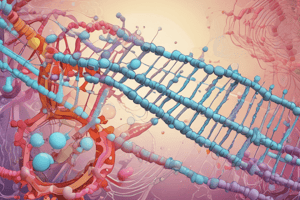Podcast
Questions and Answers
Explain the limitations of real-time PCR technology.
Explain the limitations of real-time PCR technology.
Some limitations of real-time PCR technology include inter-channel interference, limited multiplexing capabilities, restricted number of target/reporter dyes, difficulty in distinguishing live from dead cells, and the potential for subjective results leading to false-positive or false-negative outcomes.
What are the main issues in the performance evaluation of real-time PCR reagents used in clinical trials?
What are the main issues in the performance evaluation of real-time PCR reagents used in clinical trials?
The main issues in performance evaluation include analytical sensitivity, analytical specificity, accuracy, repeatability, and reproducibility.
How has real-time PCR revolutionized the diagnosis of human pathogenic viruses in clinical laboratories?
How has real-time PCR revolutionized the diagnosis of human pathogenic viruses in clinical laboratories?
Real-time PCR has revolutionized the diagnosis of human pathogenic viruses by providing rapid and accurate detection, reducing the number of production steps, and offering appropriate sensitivity and specificity within a short period of time.
What are the advantages of using real-time PCR with reverse transcription for the diagnosis of RNA viruses?
What are the advantages of using real-time PCR with reverse transcription for the diagnosis of RNA viruses?
What is the significance of the MIQE guidelines in real-time PCR experiments?
What is the significance of the MIQE guidelines in real-time PCR experiments?
Flashcards are hidden until you start studying
Study Notes
Real-Time PCR Technology and Its Limitations
- Real-time PCR should be different from single channel PCR to check for inter-channel interference
- Real-time PCR instrument should have a limited number of channels to limit the number of multiplexed targets
- Multiplexing is limited to four target/reporter dyes
- Real-time PCR reagents used in clinical trials are subjected to various performance evaluations during the development or quality control
- The minimum information for publication of quantitative real-time PCR experiments (MIQE) guidelines are the most promising among validation guidelines
- Main issues in performance evaluation include analytical sensitivity, analytical specificity, accuracy, repeatability, and reproducibility
- PCR-based techniques have been used clinically and scientifically to detect pathogens qualitatively or quantitatively, to identify mutations in pathogen genes, or to identify the types of pathogens
- Real-time PCR has revolutionized the diagnosis of human pathogenic viruses in clinical laboratories
- Real-time PCR with reverse transcription for the diagnosis of RNA viruses reduces the number of cDNA production steps and provides appropriate sensitivity and specificity within a short period
- Real-time PCR limitations include difficulty in distinguishing live from dead cells and the need for identification in bacterial strains of phenotypic and biochemical characteristics
- Fluorescence of real-time PCR is measured at each cycle and the intensity of the fluorescence signal reflects the instantaneous extent of DNA amplification
- Real-time PCR may be subjective and can produce false-positive and false-negative results based on the height of the threshold and the slope of the amplification curve
Studying That Suits You
Use AI to generate personalized quizzes and flashcards to suit your learning preferences.




